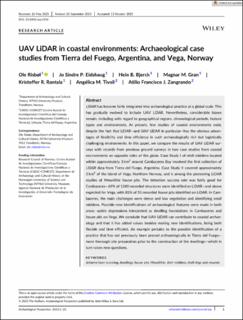| dc.contributor.author | Risbøl, Ole | |
| dc.contributor.author | Eidshaug, Jo Sindre Pålssønn | |
| dc.contributor.author | Bjerck, Hein Bjartmann | |
| dc.contributor.author | Gran, Magnar Mojaren | |
| dc.contributor.author | Rantala, Kristoffer Rolf | |
| dc.contributor.author | Zangrando, Atilio Francisco | |
| dc.contributor.author | Tivoli, Angélica M. | |
| dc.date.accessioned | 2023-12-08T07:05:49Z | |
| dc.date.available | 2023-12-08T07:05:49Z | |
| dc.date.created | 2023-11-09T12:32:51Z | |
| dc.date.issued | 2023 | |
| dc.identifier.citation | Archaeological Prospection. 2023, . | en_US |
| dc.identifier.issn | 1075-2196 | |
| dc.identifier.uri | https://hdl.handle.net/11250/3106518 | |
| dc.description.abstract | LiDAR has become fairly integrated into archaeological practice at a global scale. This has gradually evolved to include UAV LiDAR. Nevertheless, considerable biases remain, including with regard to geographical regions, chronological periods, feature types and environments. At present, few studies of coastal environments exist, despite the fact that LiDAR—and UAV LiDAR in particular—has the obvious advantages of flexibility and time efficiency in such archaeologically rich but logistically challenging environments. In this paper, we compare the results of UAV LiDAR surveys with records from previous ground surveys in two case studies from coastal environments on opposite sides of the globe. Case Study I of shell middens located within approximately 3 km2 around Cambaceres Bay involved the first collection of LiDAR data from Tierra del Fuego, Argentina. Case Study II covered approximately 3 km2 of the island of Vega, Northern Norway, and is among the pioneering LiDAR studies of Mesolithic house pits. The detection success rate was fairly good for Cambaceres—69% of 1240 recorded structures were identified on LiDAR—and above expected for Vega, with 81% of 51 recorded house pits identified on LiDAR. In Cambaceres, the main challenges were dense and low vegetation and identifying small middens. Possible new identifications of archaeological features were made in both areas: subtle depressions interpreted as dwelling foundations in Cambaceres and house pits on Vega. We conclude that UAV LiDAR can contribute to coastal archaeology and that it has added values besides making new identifications, being both flexible and time efficient. An example pertains to the possible identification of a practice that has not previously been proved archaeologically in Tierra del Fuego—more thorough site preparation prior to the construction of the dwellings—which in turn raises new questions. | en_US |
| dc.language.iso | eng | en_US |
| dc.publisher | Wiley | en_US |
| dc.rights | Navngivelse 4.0 Internasjonal | * |
| dc.rights.uri | http://creativecommons.org/licenses/by/4.0/deed.no | * |
| dc.title | UAV LiDAR in coastal environments: Archaeological case studies from Tierra del Fuego, Argentina, and Vega, Norway | en_US |
| dc.title.alternative | UAV LiDAR in coastal environments: Archaeological case studies from Tierra del Fuego, Argentina, and Vega, Norway | en_US |
| dc.type | Peer reviewed | en_US |
| dc.type | Journal article | en_US |
| dc.description.version | publishedVersion | en_US |
| dc.source.pagenumber | 25 | en_US |
| dc.source.journal | Archaeological Prospection | en_US |
| dc.identifier.doi | 10.1002/arp.1918 | |
| dc.identifier.cristin | 2194520 | |
| cristin.ispublished | true | |
| cristin.fulltext | original | |
| cristin.qualitycode | 1 | |

